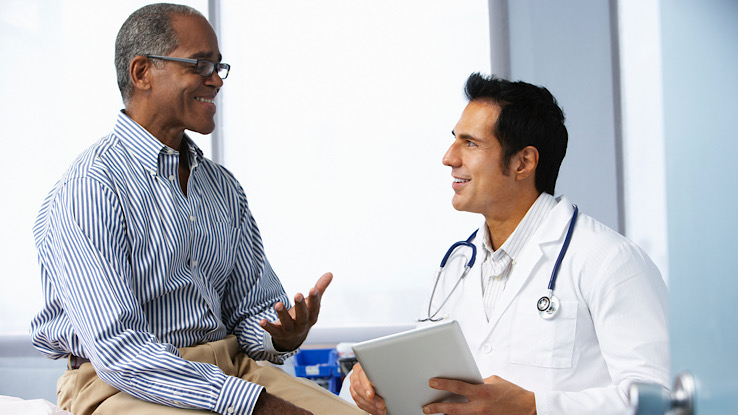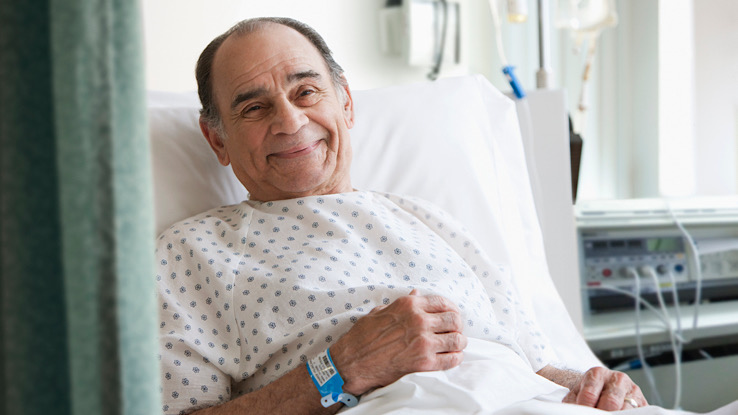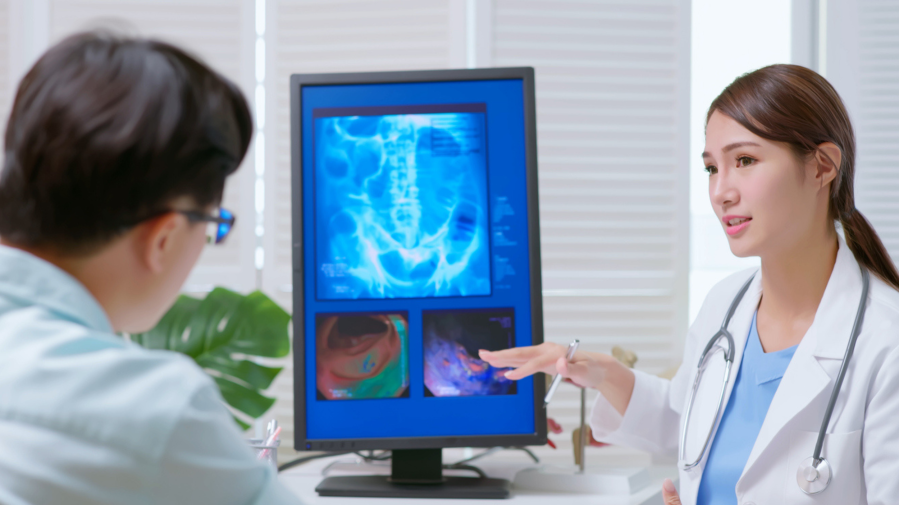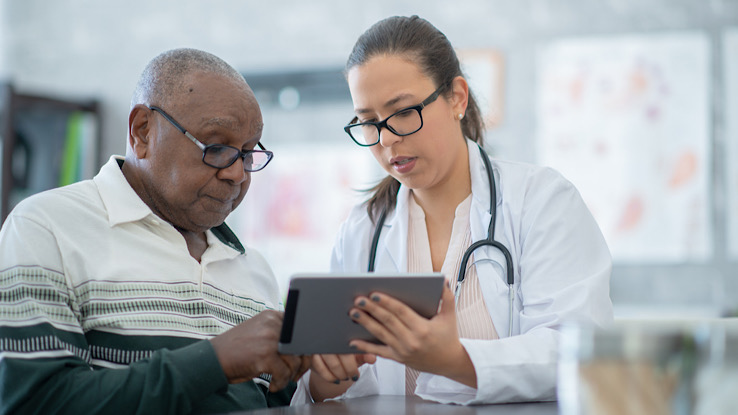
Colorectal cancer (also known as colon cancer) is the third most deadly type of cancer in the United States. There are over 50,000 deaths each year. But, when it is caught early, there are good treatment options available.
Screening and Diagnosis for Colon Cancer
Regular screening is how you can catch early signs of colon cancer. The U.S. Preventive Services Task Force (USPSTF) recommends that everyone 45 to 75 years old be screened for colon cancer. If you’re aged 76 to 85, or a high-risk patient, you should talk to your doctor about your specific screening recommendations. You may be a high-risk patient because of your age or if you have a family history of colon cancer.
A colonoscopy is one of the most common ways to screen for colon cancer. It has been proven to reduce deaths from colon cancer. If your doctor sees anything suspicious during your colonoscopy, they can take a tissue sample for testing (biopsy) during the same procedure.
Colonoscopies can also be used for diagnosis. If you have symptoms of colon cancer — like rectal bleeding, diarrhea, and abdominal pain — talk to your doctor right away.
Whether it’s for screening or diagnosis, here’s what you should know to prepare for a colonoscopy.
How Do You Prepare for a Colonoscopy?
During a colonoscopy, your doctor needs to be able to see the walls of your intestine. So you will be asked not to eat solid foods for 24 hours before the procedure. This way your intestines are totally empty.
In addition to not eating, you’ll need to do something called bowel prep. This will include:
- Using enemas (inserting liquids or gas into the rectum to empty your bowels)
- Taking laxatives
This may cause you to have multiple trips to the bathroom. Your doctor may also ask you to drink plenty of clear liquids, to stop any blood-thinning medicines, and to stop taking any iron pills.
Do They Put You to Sleep for a Colonoscopy?

Before the procedure, generally, the doctor gives you medication (anesthesia) to relax you and put you to sleep. Under anesthesia, you won’t feel any pain during the colonoscopy. After the procedure is done, you’ll usually be awake within a few minutes. Nurses and doctors will monitor you for a little while. If everything is back to your normal state, you can go home the same day.
Some doctors also offer the option to do non-sedated colonoscopy procedures, where you are not asleep. In this case, you receive pain medications but not anesthesia. If you’re interested in this option, talk with your doctor.
What Happens During a Colonoscopy?
Colonoscopies are performed in a procedure room, which is similar to an operating room. When you arrive, you’ll change into a hospital gown. In the procedure room, you’ll be asked to lie on your side with your knees pulled up to your chest.
After you’re put to sleep under anesthesia, a scope that’s half an inch wide is inserted through your anus into your large intestines. A camera on the end of the scope sends images to a monitor to be viewed in real-time by your doctor.
The scope will be inserted all the way to the start of your large intestines, then on the way back out the doctor looks closely for anything that could be cancer. This scope can also take a biopsy if needed.
Your doctor may also remove polyps they find. Polyps are extra tissue that grows inside of your body. Most polyps are not dangerous, but some can cause cancer.
How Long Does a Colonoscopy Take?
The colonoscopy procedure usually takes less than an hour. This also depends on what the doctor finds during the procedure. You’ll need to arrive to the hospital a couple of hours before your procedure and stay a couple of hours after your procedure. Most of the time you can go home the same day as your colonoscopy. But, you should plan to take the whole day off just in case.
Does a Colonoscopy Hurt?
You will be under anesthesia, so you won’t feel anything during the colonoscopy. After the procedure, you may feel some temporary discomfort, such as cramping, bloating, and gas. This is because of the pressure placed on your intestines by the scope, and the gas used to inflate and see your intestines. These symptoms should go away on their own, but if they don’t you should follow up with your doctor.
What Happens After a Colonoscopy?

After the procedure, your doctor will discuss the next steps for you. Have someone pick you up and take you home. This is because the anesthesia needs a full day to completely wear off. You may also have bleeding when you use the bathroom for the first time after the colonoscopy. If you have a lot of bleeding or strong stomach pain, you should call your doctor right away.
If your doctor removed a polyp or took a tissue sample during the procedure, you may have special instructions to follow.
What Can I Eat After a Colonoscopy?
After your colonoscopy, you can slowly return to your regular diet over the next day or so. Remember that your intestines have just been pushed and stretched by this procedure, so you may want to start with more gentle drinks and foods such as:
- Water
- Herbal teas
- Applesauce
- Yogurt
- Cooked vegetables
- Saltines
Try not to eat foods that are hard to digest right after the colonoscopy such as:
- Alcoholic beverages
- Raw vegetables
- Food with a lot of spices
- Fried foods
What Are the Risks of Colonoscopy?
As with any medical procedure, colonoscopies do have some risk, although complications are rare. These risks include:
- Bleeding
- Perforation of the intestines (a hole in the lining of your intestines)
- Reaction to the anesthesia
- Abdominal pain
Your doctor will review the risks and benefits of the procedure during your informed consent conversation. Ask any questions you have before signing the consent form.
What Are My Options for Colon Cancer Screening?

If you don’t want to have a colonoscopy for your regular colon cancer screening, you have other options.
The USPSTF has recommended three stool-based tests, which are gFOBT, FIT, and sDNA-FIT. For these three tests, you get a kit at home that you put a stool sample into. Then you send it in by mail for analysis. These tests need to be done every 1 to 3 years, whereas a colonoscopy needs to be done every 10 years.
There are also other procedure-based screening tests such as:
- CT scan colonography: This uses low-dose radiation to get images of your bowels. This procedure requires screening every 5 years.
- Flexible sigmoidoscopy: This is similar to a colonoscopy, but the doctor only examines your rectum and lower colon. The colonoscopy looks at the entire large intestines. This procedure requires screening every 5 years, or every 10 years if combined with the annual FIT stool-based test.
Talk to your doctor about which colon cancer screening option is right for you.
Resource Links:
- “Colonoscopy” via MedlinePlus
- “Colorectal Cancer Guidelines” via American Cancer Society
- “Effectiveness of screening colonoscopy in reducing the risk of death from right and left colon cancer: a large community-based study” via Gut
- “Colorectal Cancer sScreening” via Primary Care
- “Get Tested for Colorectal Cancer” via MyHealthfinder
- “The patient’s perspective – patients should be made aware of the options of sedation or no sedation and have a choice in screening colonoscopy” via Journal of Interventional Gastroenterology
- “Screening for Colorectal Cancer: US Preventive Services Task Force Recommendation Statement” via JAMA





